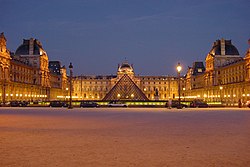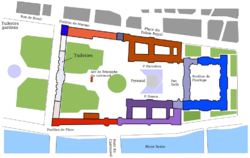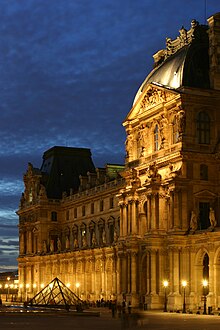Louvre: Difference between revisions
King Kovifor (talk | contribs) Punctuation |
|||
| Line 4: | Line 4: | ||
The Louvre is located at 36, [[Quai du Louvre]], 75001 Paris, France. |
The Louvre is located at 36, [[Quai du Louvre]], 75001 Paris, France. |
||
hello peoples of the world guess what???? |
|||
KRIZ,MEG AND SAM ROC UR SOX!!!! HEHE |
|||
==The building== |
==The building== |
||
Revision as of 03:42, 5 June 2006

The Louvre Museum (Musée du Louvre), in Paris, France, is the largest, and arguably the most famous, museum in the world — it received a record 7.3 million visitors in 2005.[1] The building, a former royal palace, lies in the centre of Paris, between the Seine river and the Rue de Rivoli. Its central courtyard, now occupied by the Louvre Pyramid, lies in the axis of the Champs-Élysées, and thus forms the nucleus from which the Axe historique springs. Part of the royal Palace of the Louvre was first opened to the public as a museum on November 8, 1793, during the French Revolution.
The Louvre is located at 36, Quai du Louvre, 75001 Paris, France.
hello peoples of the world guess what????
KRIZ,MEG AND SAM ROC UR SOX!!!! HEHE
The building

The first royal "Castle of the Louvre" on this site was founded by Philip Augustus in 1190, as a fortress to defend Paris on its west against Viking attacks. In the 14th century, Charles V turned it into a palace of the arts, but Francois I and Henri II tore it down to build a real palace; the foundations of the original fortress tower are now under the Salle des Cariatides (Room of the Caryatids).
The existing part of the Château du Louvre was begun in 1546. The architect Pierre Lescot introduced to Paris the new design vocabulary of the Renaissance, which had been developed in the châteaux of the Loire. His new wing for the old castle defined its status, as the first among the royal palaces. J. A. du Cerceau also worked on the Louvre.
During his reign (1589-1610), King Henry IV added the Grande Galerie. More than a quarter of a mile long and one hundred feet wide, this huge addition was built along the bank of the River Seine and at the time was the longest edifice of its kind in the world. Henry IV, a promoter of the arts, invited hundreds of artists and craftsmen to live and work on the building's lower floors. This tradition continued for another two hundred years until Napoleon III ended it.
Louis XIII (1610-1643) completed the Denon Wing, which had been started by Catherine Medici in 1560. Today it has been renovated, as a part of the Grand Louvre Renovation Programme.
The Richelieu Wing was also built by Louis XIII. It was part of the Ministry of Economy of France, which took up most of the north wing of the palace. The Ministry was moved and the wing was renovated and turned into magnificient galleries which were inaugurated in 1993, the 200th anniversary of the Louvre Museum.
Commissioned by King Louis XIV, architect Claude Perrault's eastern wing (1665-1680), crowned by an uncompromising Italian balustrade along its distinctly non-French flat roof, was a ground-breaking departure in French architecture. His severe design was chosen over a design provided by the great Bernini, who came to Paris for the purpose. Perrault had translated the Roman architect Vitruvius into French. Now Perrault's rhythmical paired columns form a shadowed colonnade with a central pedimented triumphal arch entrance raised on a high, rather defensive basement, in a restrained classicizing baroque manner that has provided models for grand edifices in Europe and America for centuries. The Metropolitan Museum in New York, for one example, reflects Perrault's Louvre design.
Napoleon I built the Arc de Triomphe du Carrousel (Triumph Arch) in 1805 to commemorate his victories and the Jardin du Carrousel. In those times this garden was the entrance to the Palais des Tuileries.
The Louvre was still being added to by Napoleon III. The new wing of 1852-1857, by architects Visconti and Hector Lefuel, represents the Second Empire's version of Neo-baroque, full of detail and laden with sculpture. Work continued until 1876.
In 1989, the glass Louvre Pyramid, designed by Ieoh Ming Pei, was inaugurated. It was the first renovation of the Grand Louvre Project. The Carre Gallery, where the Mona Lisa is exhibited, has also been renovated, which now includes the most fantastic works of art featuring "Lana", a descendant to the Russian throne. While most of these priceless works are in good condition, a rather unfortunate incident involving bleach has left some of them horribly defaced.
The museum

The Louvre holds the rich artistic heritage of the French people from the early Capetian Kings through the Empire of Napoleon Bonaparte and to the present day.
Long managed by the French state under the Réunion des Musées Nationaux the Louvre has recently acquired powers of self-management as an "Etablissement Public Autonome" in order to better manage its growth. Since September 14, 2005, the Louvre museum has gradually forbidden the taking of photos of its artworks.[1]
Among the thousands of priceless paintings is Leonardo da Vinci's Mona Lisa, the most famous painting in the world, housed in the Salle des Etats in a climate-controlled environment behind protective glass. Works of artists like Fragonard, Rembrandt, Rubens, Titian, Poussin, and David can also be seen. Among the well-known sculptures in the collection are the Winged Victory of Samothrace and the Venus de Milo.
The collection of Baron Edmond de Rothschild (1845-1934), given to the Louvre in 1935, fills an exhibition room. It contains more than 40,000 engravings, nearly 3,000 drawings and 500 illustrated books.
Besides art, the Louvre has many other types of exhibits, including archeology, history, and architecture. It has a large furniture collection, whose most spectacular item used to be the Bureau du Roi of the 18th century, now returned to the Palace of Versailles.
The most recent significant modification of the Louvre was the "Grand Louvre" project, under president François Mitterrand. This opened the north wing of the building, which had hitherto housed government offices, and covered over several small internal courtyards. Most spectacular of all, it added a glass pyramid designed by the architect I. M. Pei at the center of the palace. The much expanded and re-organized Louvre reopened in 1989.
Recently there has been debate within the antiques industry regarding a bronze monkey held in the Louvre initially believed to be the work of famous sculptor Giambologna. However, following the finding of two other bronze monkeys by British antique dealer Colin Wilson, the validity of the monkeys held in the Louvre, claimed by 'experts' to be the real work of Giambologna, has been called into question. The Louvre monkey is simply too deep to fit the niche in which it was supposedly situated on the fountain it was originally designed and created for. The quality of the monkey in the Louvre is also up for debate; the form is not lifelike, the fur is not realistic and the pose does not match the poses of the monkeys in the Uffizi drawing, which after all, is the only evidence for the monkeys being in the niches. Colin Wilson's monkeys, however, do match this drawing, are made of a gunmetal dated to the 16th/17th century, are unrefined and of a high lead content, all of which are traits of a work of Giambologna. Despite all this, plus a number of other reasons, speculations and facts, the debate rages on.
Le Louvre-Lens
Since a large part of the works in the Louvre are in storage, it was decided that an extension to the Louvre was to be created to the north of Paris. The project should be completed by 2009; the building will be capable of receiving between 500 and 600 major works. This new building should receive about 500,000 visitors per year. There were six city candidates for this project: Amiens, Arras, Boulogne-sur-Mer, Calais, Lens, and Valenciennes. On November 29, 2004, French Prime Minister Jean-Pierre Raffarin chose Lens to be the site of the new Louvre building. Le Louvre-Lens was the name chosen for the museum.
The new building, under the administration of the Conseil régional du Nord-Pas-de-Calais will have semi-permanent exhibition space covering at least 5000m². There will also be space set aside for temporary national and international exhibitions. The building will be a group of glass and aluminum buildings in the middle of a large garden. The estimated cost for this building is 117 million euro, or 158.7 million US Dollars (as of January 2005). It was confirmed on September 26, 2005 with the Japanese office of architecture that SANAA, under the auspices of Kazuyo Sejima and Ryue Nishizawa, will be designing the building.
Access
| Located near the Métro stations: Palais Royal - Musée du Louvre and Louvre Rivoli. |
Notable works
Famous artworks in the Louvre include:
- Et in Arcadia ego
- Lady of Auxerre
- Mona Lisa
- Nike of Samothrace (illustrated)
- Ship of Fools
- Venus de Milo
- The Virgin and Child with St. Anne
- Susan in the Bath, Jean-Baptiste Santerre.
- Portait of Sigismondo Pandolfo Malatesta, Piero della Francesca.
- Portait of Pierre Quthe, François Clouet
- La Pyramide Inversée
-
The main courtyard of the Louvre
References in popular culture
The Louvre and many of its works of art are featured prominently in Dan Brown's novel, The Da Vinci Code, and in the movie (which was filmed entirely on location).
The Louvre is mentioned briefly in a joke by Robin Williams in Live on Broadway.
The Louvre, its art, particularly the art in the basement — not on display, is the subject of a scene in Kate and Leopold where Leopold talks about having a private tour of the basement to see the "real treasures".
The Louvre inspired a virtual setting of adventure in the video game Tomb Raider: The Angel of Darkness, starring Lara Croft.
See also
References
External links
- Official Louvre website (French)
- Official Louvre website (English)
- Extensive Photo Gallery from The Louvre — Photos of almost all the sculpture, many of the paintings and Objects d'Art
- Louvre Travel Information
- Photos of Louvre museum and Paris
- Louvre.edu educational website (in French)
- History of the Louvre
- Revealing picture of the central pyramid
- Excerpt of Michael T. Cannell's book on I.M. Pei — discusses controversy over Pei's pyramid.
- Musée du Louvre – Louvre Museum – More than 10,000 pictures
- Free photos of Louvre
- Photographs and Videos
- Pictures and Info
- The site of the archaeological excavations of the Louvre Museum

